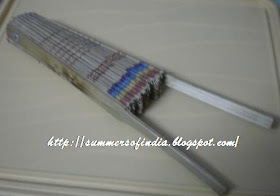Basics
I want to share with you my experiments and experiences with Quilling Craft. I want to share with you the techniques, designs patterns and how I did them. I will post tutorials, links and my creations.
So come Learn With Me Quilling.....
A Little about Quilling:
Quilling- is the art of rolling strips of paper, shaping, sticking together and on some back ground. In case of 3D shapes no back ground is used.
Since the Quill or feather was used for rolling the paper strips, this art got its name Quilling.
There is lot of uncertainty as to the origin of Quilling or Paper Filigree as also known as. Some say the French and Italian nuns and monks used this art. Some say this is an old art form and originated after the invention of paper and hence may be in China.
Metal filigree-filigree in gold, silver etc was much in vogue since ancient times in making of jewellery and other things. This was and still is popular in India where we have silver nd other filigree works. But this was restricted to rich and royal because of its cost. Subsequently filigree in other metals like iron etc came into existence. So some believe that paper was used as an inexpensive material for creating filigree items and this became popular as Quilling Craft.
During the 18th century quilling was popular with elite European ladies and from there it spread to America. Furniture, purses etc were decorated with quilling. But it lost its popularity over a period of time.
Any way today this craft has become popular across the world and there have been changes in the art form, materials and styles/techniques used. At present dimensional or 3D quilling is also popular.
Materials Required:
Paper: Quilling paper is (acid free) available in solid colours, two toned, graduated etc. solid means one colour through out, two toned is solid colour one side and a softer shade on the other side and graduated means the colour starts with darker shade and slowly fades away into lighter shade or white. Apart from this today we have metallic and jewel shades too.
We can get sheets and cut into desired width. But it is better to buy the strips available in the market. These are available in 2mm, 3mm, 5mm, 8mm and 10mm strips in Indian markets. They are available in bunches(packs) of single colours or rainbow colours.
Quilling Tool: This is of two types, needle type and one with a slot. Both have handles made of plastic for easy holding. The slot type has a small slit in the needle through which the paper is passed. This helps to grip the paper strip and thus easy to roll. One can always use a tooth picks, pins or hat pins etc too for rolling.
Quilling Circle Template Board: This is an useful tool for creating rolls or circles of various sizes. This is available in many sizes.
Quilling Comb: Is useful for some techniques. But one can manage using ordinary hair comb or pins too.
Pins: long pins with pearl or bead head are ideal for holding the work in place while coiling or making the desired shape.
Scissors: Small one with sharp point is good. Use any simple scissors used for paper cutting or in crafts.
Tweezers: Quilling tweezers with pointed or fine tips are useful in handling small rolls or when working on rolls, soils etc.
Ruler: This comes in handy for measuring.
Glue: Any craft glue is enough.
Crimper, Fringer are other tools which come in handy while creating designs. Crimper helps in crimping the paper strips where as fringer helps in cutting the fringes.
But the basic tools required are paper strips, needle or toothpick, pins, scissors and glue to start with.
My tools
Quilling Papers
In the next post we will learn the basic shapes and how to make them...So keep an eye on my blog...






























